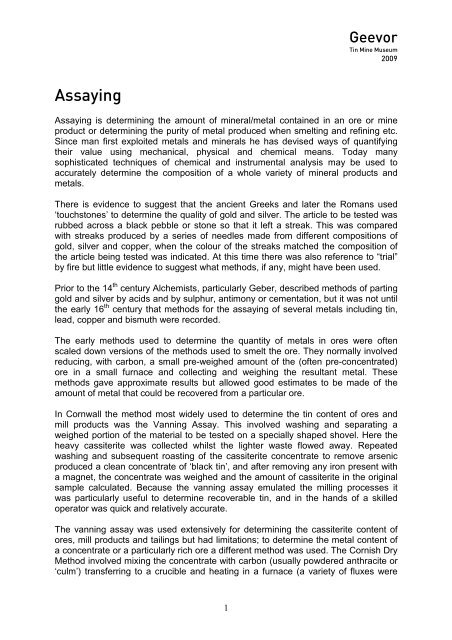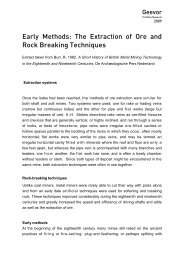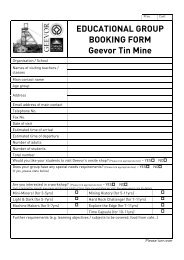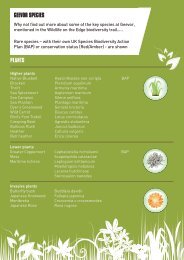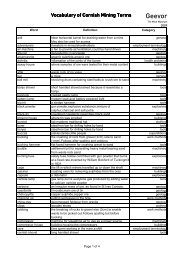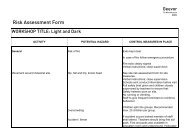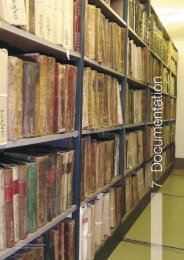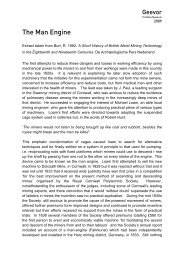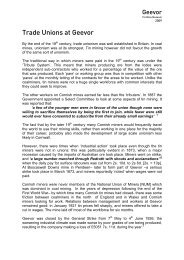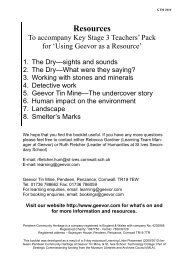Assaying - Geevor Tin Mine
Assaying - Geevor Tin Mine
Assaying - Geevor Tin Mine
You also want an ePaper? Increase the reach of your titles
YUMPU automatically turns print PDFs into web optimized ePapers that Google loves.
<strong>Geevor</strong><br />
<strong>Tin</strong> <strong>Mine</strong> Museum<br />
2009<br />
<strong>Assaying</strong><br />
<strong>Assaying</strong> is determining the amount of mineral/metal contained in an ore or mine<br />
product or determining the purity of metal produced when smelting and refining etc.<br />
Since man first exploited metals and minerals he has devised ways of quantifying<br />
their value using mechanical, physical and chemical means. Today many<br />
sophisticated techniques of chemical and instrumental analysis may be used to<br />
accurately determine the composition of a whole variety of mineral products and<br />
metals.<br />
There is evidence to suggest that the ancient Greeks and later the Romans used<br />
‘touchstones’ to determine the quality of gold and silver. The article to be tested was<br />
rubbed across a black pebble or stone so that it left a streak. This was compared<br />
with streaks produced by a series of needles made from different compositions of<br />
gold, silver and copper, when the colour of the streaks matched the composition of<br />
the article being tested was indicated. At this time there was also reference to “trial”<br />
by fire but little evidence to suggest what methods, if any, might have been used.<br />
Prior to the 14 th century Alchemists, particularly Geber, described methods of parting<br />
gold and silver by acids and by sulphur, antimony or cementation, but it was not until<br />
the early 16 th century that methods for the assaying of several metals including tin,<br />
lead, copper and bismuth were recorded.<br />
The early methods used to determine the quantity of metals in ores were often<br />
scaled down versions of the methods used to smelt the ore. They normally involved<br />
reducing, with carbon, a small pre-weighed amount of the (often pre-concentrated)<br />
ore in a small furnace and collecting and weighing the resultant metal. These<br />
methods gave approximate results but allowed good estimates to be made of the<br />
amount of metal that could be recovered from a particular ore.<br />
In Cornwall the method most widely used to determine the tin content of ores and<br />
mill products was the Vanning Assay. This involved washing and separating a<br />
weighed portion of the material to be tested on a specially shaped shovel. Here the<br />
heavy cassiterite was collected whilst the lighter waste flowed away. Repeated<br />
washing and subsequent roasting of the cassiterite concentrate to remove arsenic<br />
produced a clean concentrate of ‘black tin’, and after removing any iron present with<br />
a magnet, the concentrate was weighed and the amount of cassiterite in the original<br />
sample calculated. Because the vanning assay emulated the milling processes it<br />
was particularly useful to determine recoverable tin, and in the hands of a skilled<br />
operator was quick and relatively accurate.<br />
The vanning assay was used extensively for determining the cassiterite content of<br />
ores, mill products and tailings but had limitations; to determine the metal content of<br />
a concentrate or a particularly rich ore a different method was used. The Cornish Dry<br />
Method involved mixing the concentrate with carbon (usually powdered anthracite or<br />
‘culm’) transferring to a crucible and heating in a furnace (a variety of fluxes were<br />
1
<strong>Geevor</strong><br />
<strong>Tin</strong> <strong>Mine</strong> Museum<br />
2009<br />
often used to assist fusion) to produce tin metal. This was poured into a small ingot<br />
mould, and when cool, freed from adhered slag and weighed. The slag was often retreated<br />
to recover any entrained metal. A similar method was to fuse the sample with<br />
cyanide to produce a bead of metal for weighing.<br />
The procedure for copper ores was more complex and required several fusions to<br />
eliminate sulphur and concentrate and reduce the copper. During the 17 th –19 th<br />
centuries these ‘dry’ methods were widely used on Cornish tin and copper mines. By<br />
the mid 19 th century ‘wet’ methods of chemical analysis were being increasingly used<br />
to accurately determine the metal content of a whole range of mine products.<br />
During the 19 th century a greater understanding of chemical processes and their<br />
application for analysis saw many new assay methods being developed. By the end<br />
of the 19 th century many mines had set up laboratories for the routine assay of<br />
underground and mill samples, though the vanning shovel still remained an<br />
important tool until the end of the 20 th century.<br />
The ‘wet’ chemical analysis of tin became increasingly popular from about 1870.<br />
Cassiterite (tin oxide) is unusual in that, under normal conditions, it is insoluble in<br />
any combination of acids or alkali. To bring cassiterite into solution it must first be<br />
reduced to metal. Heating the cassiterite in an atmosphere of hydrogen (usually as<br />
coal gas) was very effective in bringing about this reduction. Once reduced the<br />
sample was dissolved in hydrochloric acid to bring the tin into solution as stannous<br />
chloride.<br />
<strong>Tin</strong> like many metals can combine with other elements in different ratios. When tin<br />
dissolves in hydrochloric acid one atom of tin combines with two atoms of chlorine to<br />
produce one molecule of stannous chloride (SnCl2), thus the tin is said to be in the<br />
lowest oxidation or stannous state. By oxidising the stannous chloride the tin can be<br />
made to combine with more chlorine to produce stannic chloride with four atoms of<br />
chlorine combined with one atom of tin (SnCl4). Reacting the stannous chloride with<br />
an oxidising agent like iodine can bring about this oxidation. It always requires a<br />
fixed amount of oxidising agent to effect this change.<br />
Thus if a sample containing cassiterite is finely ground, accurately weighed, reduced<br />
by heating in hydrogen, dissolved in hydrochloric acid and the solution reacted with a<br />
measured amount of iodine solution of known strength, then the amount of iodine<br />
used is equivalent to the amount of tin in the original sample. In practice the iodine<br />
solution is slowly added to the solution of stannous chloride, from a burette, oxidising<br />
it to stannic chloride. The end of the reaction is indicated by adding a few drops of<br />
starch to the solution this changes from colourless to dark blue with the first drop of<br />
excess iodine.<br />
This method gave accurate and consistent results and by adjusting sample weights<br />
and solution strengths could be used to assay tailing samples with less than 0.5% tin<br />
to concentrates with over 70.0 % tin.<br />
2
<strong>Geevor</strong><br />
<strong>Tin</strong> <strong>Mine</strong> Museum<br />
2009<br />
Several other assay routines for tin were also developed around this time. The<br />
Pearce-Low method used fused sodium hydroxide or better still sodium peroxide to<br />
attack the sample and convert the cassiterite to soluble sodium stannate (this is the<br />
preferred method for tin ores today) and iodine was often replaced by other oxidising<br />
agents like potassium permanganate or potassium iodate /iodide solution.<br />
Around 1912 a modification of the tin assay was demonstrated and rapidly gained<br />
popularity. The Beringer assay used zinc metal instead of hydrogen to reduce the<br />
cassiterite in the sample. The sample to be assayed was mixed with a small amount<br />
of zinc oxide and powdered zinc metal, transferred to a small, covered crucible and<br />
heated to a bright orange (about 950 degrees) for 10-15 minutes, after cooling, the<br />
contents of the crucible were dissolved in hydrochloric acid and titrated with iodine<br />
as before.<br />
By the early 20 th century wet chemical methods for the assay of all of the different<br />
metal encountered in the Cornish mines had been developed and refined so that<br />
ores, mill products and concentrates could be accurately analysed and evaluated to<br />
allow the efficiency and recovery of the milling processes to be determined.<br />
From the 1940’s systems of instrumental analysis were being developed to<br />
streamline and automate analysis procedures. Instruments to analyse the spectra<br />
emitted and absorbed when metals are vaporised were developed into systems that<br />
could routinely analyse samples of ores, feeds and tailings etc, though instrumental<br />
analysis was not suitable for high grade concentrates and smelter returns.<br />
By the 1960’s systems utilising the properties of X-ray fluorescence were being<br />
developed and by the early 70’s were commercially available to analyse a variety of<br />
metals including tin. These systems had the advantage of being able to analyse<br />
samples without the need to bring them into solution. It was also possible to measure<br />
material flowing through pipes so that the continuous and automated analysis of<br />
metals in feed and tailing streams was possible.<br />
At <strong>Geevor</strong> several systems of analysis were used to quantify the tin and other metals<br />
present in the ore, mill products and concentrates produced for sale. A plan of the<br />
mine from 1912 shows the Assay Office occupying the present sample house. Here<br />
samples would have been prepared and assayed using both vanning and chemical<br />
methods, with the upper of the two rooms being used for chemical analysis.<br />
Just before the Second World War chemical analysis was moved to a small<br />
laboratory (originally built in 1926 to support the Sulman and Picard experimental tin<br />
fuming plant) sited on the lower part of the mine adjacent to the mill. Here mill feed,<br />
tailing and concentrate samples were assayed on a daily basis using the Beringer<br />
(zinc reduction) chemical assay. In addition the sulphides from the flotation circuits<br />
were assayed for their copper and arsenic content and occasionally mill test work<br />
required other metals like iron, tungsten and bismuth to be assayed using wet<br />
chemical methods.<br />
3
<strong>Geevor</strong><br />
<strong>Tin</strong> <strong>Mine</strong> Museum<br />
2009<br />
The original assay office continued in use until 1986 (now called the sample house)<br />
for the preparation and subsequent vanning of an increasing number of samples<br />
from exploration, development and stoping operations underground.<br />
In 1980 a new wet chemical laboratory, with improved fume extraction equipment<br />
and storage facilities, was built in the New Table Plant to replace the now antiquated<br />
1926 laboratory. Here routine chemical analysis was continued augmented by the<br />
introduction of an Asoma X-ray fluorescence analyser.<br />
X- ray fluorescence analysers were developed in the 1960’s and 70’s. When an<br />
element is exposed to a beam of X-rays of suitable energy it emits secondary X-rays<br />
whose energies are characteristic of that element. Thus if the energies and<br />
intensities of the secondary X-rays emitted by the sample are measured the<br />
elements present and their concentrations may be determined.<br />
In 1972 an on stream XRF analyser was trailed at <strong>Geevor</strong>, the system known as<br />
Mintek measured the tin content of the three tailings (waste) streams from the mill.<br />
As tailing streams passed over the building housing the analyser a representative<br />
sample of each stream was sequentially selected and passed through the analyser<br />
where it was exposed to a beam X-rays generated by a radioisotope source/target<br />
assembly, a gamma-ray solids gauge measured the solids contents of the streams<br />
whilst a detector measured the secondary X-rays emitted from the sample. The<br />
output from the detectors was electronically filtered and adjusted to compensate for<br />
variations in the sample matrix. The whole system was automatic being controlled by<br />
a small computer linked to a teletype. This printed a continuous record of the tin and<br />
solids content of the tailing streams.<br />
In 1975 a second Mintek system was installed to monitor and report the tin content of<br />
the three mill-feed streams. An important feature of the system was to incorporate an<br />
alarm to give warning when tin losses in the tailings exceeded predetermined levels.<br />
Thus from 1975 to 1986 the amount of tin entering and leaving the mill was<br />
automatically and continuously monitored doing away with the need to chemically<br />
assay the samples.<br />
During the 1970’s and 80’s XRF analysers were continually developed and refined.<br />
At the Wheal Jane <strong>Mine</strong> a Mintek system was installed in 1975 to monitor tin levels<br />
in flotation plant streams. A little later a Philips PW 1220C X-ray Spectrometer was<br />
installed. This, multi element machine, was capable of analysing 180 samples per<br />
day.<br />
By 1980 at <strong>Geevor</strong> an Asoma 8010 six elements XRF analyser was in use to<br />
analyse routine mill samples and to check underground samples that had been<br />
previously vanned. Sample preparation for this analyser was minimal, samples only<br />
needed to be dried and finely ground before being placed into a measuring cell and<br />
positioned on the machine. Analysis took only a few minutes and could be performed<br />
by persons with minimal training.<br />
4
<strong>Geevor</strong><br />
<strong>Tin</strong> <strong>Mine</strong> Museum<br />
2009<br />
By 1988 a second more advances Asoma was purchased, this machine was selfcalibrating<br />
and programmable to allow a whole range of samples to be analysed.<br />
At the time of the mines closure the Asoma XRF analyser was used for the daily<br />
checking of mill samples etc (the Mintek system was not operable after 1986). The<br />
tin concentrates sold for smelting continued to be assayed by wet chemical methods<br />
along with various calibration and smelter exchange samples.<br />
Irrespective of what method of assaying is used the sample being tested must be<br />
truly representative of the whole. If it is not then the result will always be suspect.<br />
5


